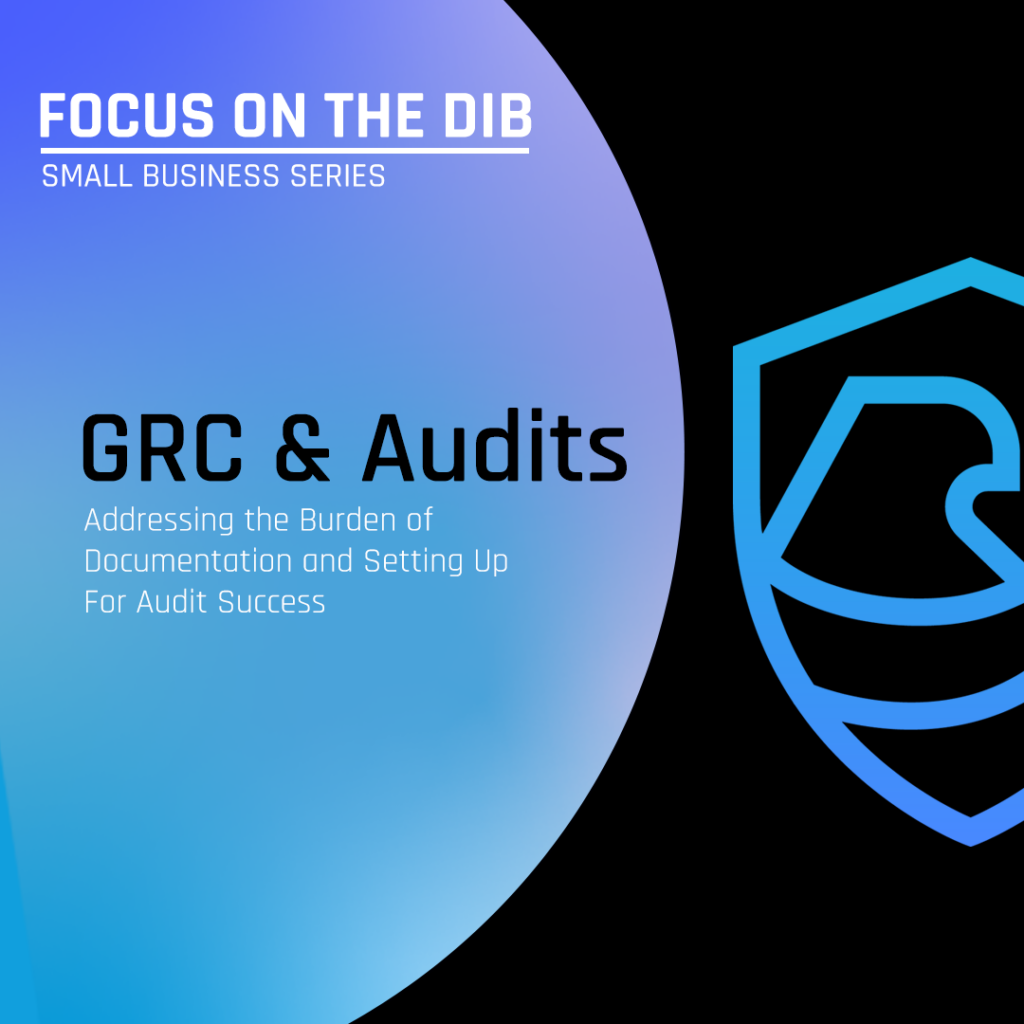Security Documentation is Essential for GRC and Audit Preparation

Prioritizing Policy Documentation as a Critical Component for Implementation and Audit Preparation
Policy documentation is a hot topic in the Defense Industry Base (DIB) and is found in many small businesses to be a challenge if it has not already been made a priority. We must note that this is a consistent problem across businesses of all sizes that increases with complexity as organizations grow in scope and size. In this blog post, we answer three common questions about policy documentation in the small business space.
Why is documentation perceived as a burden for small businesses?
Limited Staff: Small businesses often have limited human resources. Employees may wear multiple hats, and dedicating time to document processes and procedures may be seen as a luxury rather than a necessity.
Time Constraints: Small businesses are often focused on day-to-day operations and immediate priorities. Taking time away from operational tasks to document processes may be viewed as time-consuming and potentially disruptive. Small businesses often face multiple priorities, and documentation may not be at the top of the list. Other pressing issues, such as customer demands, or immediate operational needs almost always take precedence.
Perceived Lack of Value: Employees may prioritize activities that yield immediate results or have a direct impact on daily operations. Documentation, on the other hand, might not provide immediate tangible benefits.
Informality: Small businesses often have a more informal culture where information is shared verbally or through informal channels. The need for formal documentation may seem unnecessary.
Lack of Understanding: Employees may not fully understand the purpose and benefits of documentation. If the value of having organized and well-documented processes is not clear, employees may not see it as a priority.
Flexibility Concerns: Small businesses often pride themselves on being nimble and flexible. There can be a fear that documentation might introduce unnecessary rigidity or bureaucracy into the workflow.
Inconsistent Practices: In small businesses, employees may have varying approaches to tasks, and there might be a lack of standardized processes. The prospect of documenting processes may highlight these inconsistencies.
Complexity of Documentation: Some employees may find the process of creating documentation daunting, especially if they perceive it as a complex task requiring extensive writing or technical skills.
Technology Constraints: Small businesses may lack the necessary tools or systems to facilitate easy and efficient documentation. The absence of user-friendly documentation tools can contribute to the perception of it being burdensome.
To address these challenges, it’s important for small businesses to internally communicate the value of documentation, emphasizing how it contributes to efficiency, consistency, and scalability. Providing training, simplifying the documentation process, and integrating it into existing workflows can also help overcome resistance and make it a more manageable task for employees. Additionally, demonstrating the long-term benefits of having well-documented processes can help shift the perception of documentation from a burden to an essential and strategic investment.
Where should small businesses start if documentation hasn’t been a priority?

Initiating a documentation plan and process for a small business, especially if it hasn’t been a priority in the past, may seem like a daunting task. However, it’s a crucial step toward improving efficiency, ensuring consistency, supporting business growth, and becoming compliant in industry. Here’s a guide to help a small business kickstart this criticality:
1. Identify Key Processes: Begin by identifying the key processes within the business. These could include customer onboarding, order processing, inventory management, and data sharing procedures. Focus on the most critical aspects of your operations. A business may find it helpful to illustrate a process by a process flow. This could help visualize not only the process, but the data flow, which, if you remember from the first blog post in this series, is important when identifying the data used in the business.
2. Prioritize Documentation Needs: Prioritize which processes need documentation first based on their impact on the business. Start with the most critical or frequently performed processes to maximize the immediate benefits of documentation.
3. Set Clear Objectives: Define clear objectives for documentation. Clearly communicate the purpose, emphasizing how it will improve efficiency, reduce errors, and facilitate training for new employees. Align these objectives with the overall business goals.
4. Allocate Resources: Assign dedicated resources to the documentation process. This could be an individual or a small team responsible for creating, organizing, and updating documentation. Ensure they have the time and tools needed to perform this task effectively.
5. Document Current Processes: Begin documenting existing processes. Encourage employees to outline their daily tasks, step-by-step procedures, and any important details. Capture both formal and informal processes that contribute to the overall workflow.
6. Use Simple Documentation Tools: Choose simple and user-friendly documentation tools. This could include word processors, spreadsheets, or dedicated documentation software. Documentation doesn’t have to be ‘fancy.’ The goal is to make the process accessible and not overly complex. Arguably, the evolution of the process may be more complicated in the future, but for the sake of getting a starting point, this is a good baseline set in reality.
7. Create Standard Operating Procedures (SOPs): Develop Standard Operating Procedures (SOPs) for key processes. SOPs provide a standardized way of performing tasks and are crucial for maintaining consistency across the business.
8. Include Visuals and Examples: Enhance documentation with visuals and examples. Use flowcharts, diagrams, or screenshots to illustrate processes. Visual aids can make documentation more accessible and easier to understand.
9. Seek Employee Input: Involve employees in the documentation process. Seek their input on existing processes and encourage them to contribute to the documentation. This not only captures valuable insights but also fosters a sense of ownership.
10. Provide Training: Offer training sessions on the importance of documentation and how to use the newly created documents. This can help employees understand the value and encourage compliance.
11. Establish a Documentation Repository: Create a centralized repository for documentation. This could be a shared drive, a cloud-based platform, or a dedicated section on the company intranet. Having a centralized location makes it easier for employees to access and update documents.
12. Set Review and Update Procedures: Establish regular review and update procedures for documentation. Processes evolve, and it’s important to ensure that documentation remains accurate and relevant. Assign responsibility for keeping documents up-to-date. Monitor the implementation of documentation and gather feedback. Evaluate its impact on efficiency, consistency, and overall business operations. Use feedback to make continuous improvements.
How can good documentation prepare a small business for a successful audit?
Good documentation is critical for preparing and navigating through an audit effectively. Well-documented processes and records can significantly ease the audit process and demonstrate that your business operates in a transparent and compliant manner. Here are ways in which good documentation can prepare you for an audit, specifically for a NIST 800-171 or CMMC audit.
- Thorough Familiarity: Good documentation ensures that key personnel are familiar with the requirements outlined in NIST 800-171. Understand the security controls and practices that need to be implemented to protect CUI.
- Develop a System Security Plan: Creating a comprehensive System Security Plan that documents how your organization implements and manages security controls. This plan should be easily accessible to auditors and provide an overview of your security posture. The easier the plan is to read, the better. In many cases, a small business may find matching the numbering system to NIST 800-171 to their own SSP makes sense for not only documentation management but audit support, too.
- Policy Documentation: Clearly document security policies and procedures aligned with NIST 800-171. This includes access control policies, incident response procedures, and other relevant security-related documents.
- Document Implementation: Provide evidence that security controls are not only defined in documentation but are also actively implemented. This evidence can include configuration documentation, system logs, and records of security assessments.
- CUI Inventory: Maintain a comprehensive inventory of all Controlled Unclassified Information (CUI) within your organization. Document how CUI is identified, classified, and protected. Cross-reference this to the business’ processes and documented policies.
- Configuration Management Documentation: Document processes related to configuration management, including baseline configurations, change management procedures, and how unauthorized changes are prevented.
- Audit Trail Records: Keep detailed records of security audits and monitoring activities. This documentation serves as evidence that security controls are actively monitored for compliance.
- Prepare for Continuous Monitoring:
- Continuous Monitoring Documentation: Document how your organization conducts continuous monitoring of security controls. This includes regular assessments, updates to the SSP, and ongoing risk management activities.
- Mock Audit Documentation: Conduct mock audits internally to identify any gaps in your documentation and implementation. Use the results to refine your documentation and improve security controls.
- Collaborate with Auditors to Facilitate Open Communication: Work closely with auditors and maintain open communication throughout the audit process. Provide them with access to relevant documentation and be prepared to address any questions or concerns. By establishing and maintaining good documentation practices that align with the requirements of NIST 800-171, your organization can demonstrate a commitment to security, facilitate the audit process, and increase the likelihood of achieving compliance. Keep in mind that documentation is not only about meeting audit requirements but also about enhancing the overall security posture of your organization.
The Bottom Line: documentation is simply the most critical piece in in achieving and maintaining CMMC compliance as it provides the essential evidence of implementation, which will make or break an audit. Not only does it validate the integration of supporting risk and management efforts, but it also ensures consistency and standardization which are the magic words for auditors to hand over a certification. Essentially, get this right, and you can fast track your way to lasting, compliant, success.
Sentinel Blue is a managed security service provider (MSSP) that works daily with the DIB tackling operational and security challenges designed to streamline effective agency/prime/sub collaboration, secure architecture and IT environments, mitigate threats and implement incident response best practice.

